
Operation Swift was a military operation in the Vietnam War, launched by units of the U.S. 1st Marine Division to rescue two Marine companies which had been ambushed by the People's Army of Vietnam (PAVN). The operation took place in the Quế Sơn Valley, beginning on 4 September 1967. In the ensuing battles, 127 Marines and an estimated 600 PAVN were killed.
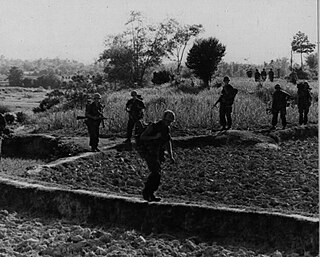
Operation Union was a search and destroy mission in the Que Son Valley carried out by the 1st Marine Regiment from 21 April to 16 May 1967. The object of the operation was to engage the People’s Army of Vietnam (PAVN) 2nd Division.

Operation Union II was a search and destroy mission in the Quế Sơn Valley carried out by the 5th Marine Regiment. Launched on 26 May 1967 the operation ended on 5 June. U.S. reported the People's Army of Vietnam (PAVN) lost 701 killed and 23 captured, while U.S. casualties were 110 killed and 241 wounded.

Operation Masher, also known as Operation White Wing, was the largest search and destroy mission that had been carried out in the Vietnam War up until that time. It was a combined mission of the United States Army, Army of the Republic of Vietnam (ARVN), and Republic of Korea Army (ROK) in Bình Định Province on the central coast of South Vietnam. The People's Army of Vietnam (PAVN) 3rd Division, made up of two regiments of North Vietnamese regulars and one regiment of main force Viet Cong (VC) guerrillas, controlled much of the land and many of the people of Bình Định Province, which had a total population of about 800,000. A CIA report in 1965 said that Binh Dinh was "just about lost" to the communists.
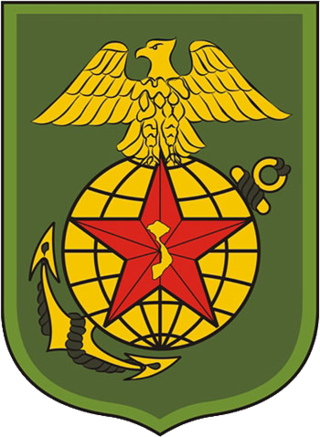
The Republic of Vietnam Marine Division was part of the armed forces of South Vietnam. It was established by Ngo Dinh Diem in 1954 when he was Prime Minister of the State of Vietnam, which became the Republic of Vietnam in 1955. The longest-serving commander was Lieutenant General Le Nguyen Khang. In 1969, the VNMC had a strength of 9,300, 15,000 by 1973, and 20,000 by 1975.

The Vietnamese Rangers, commonly known as the ARVN Rangers, were the light infantry of the Army of the Republic of Vietnam. Trained and assisted by American Special Forces and Ranger advisers, the Vietnamese Rangers infiltrated beyond enemy lines in search and destroy missions. Initially trained as a counter-insurgency light infantry force by removing the fourth company each of the existing infantry battalions, they later expanded into a swing force capable of conventional as well as counter-insurgency operations, and were relied on to retake captured regions. Later during Vietnamization the Civilian Irregular Defense Group program was transferred from MACV and integrated as Border Battalions responsible for manning remote outposts in the Central Highlands.

Phase Two of the Tet Offensive of 1968 was launched by the People's Army of Vietnam (PAVN) and Viet Cong (VC) against targets throughout South Vietnam, including Saigon from 29 April to 30 May 1968. The May Offensive was considered much bloodier than the initial phase of the Tet Offensive. U.S. casualties across South Vietnam were 2,169 killed for the entire month of May, making it the deadliest month of the entire Vietnam War for U.S. forces, while South Vietnamese losses were 2,054 killed. PAVN/VC losses exceeded 24,000 killed and over 2,000 captured. The May Offensive was a costly defeat for the PAVN/VC.

The 1st Division of the Army of the Republic of Vietnam (ARVN)—the army of the nation state of South Vietnam that existed from 1955 to 1975—was part of the I Corps that oversaw the northernmost region of South Vietnam, the centre of Vietnam.
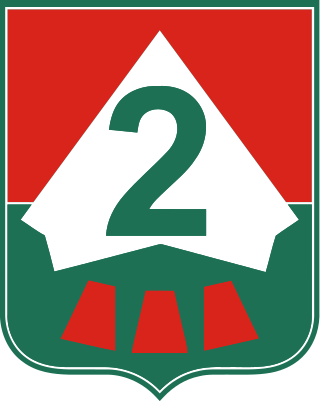
The 2nd Division was a division of the Army of the Republic of Vietnam (ARVN)—the army of the nation state of South Vietnam that existed from 1955 to 1975. It was part of I Corps that oversaw the northernmost region of South Vietnam.
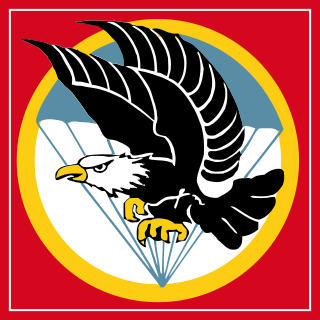
The Vietnamese Airborne Division was one of the earliest components of the Republic of Vietnam Military Forces. The Vietnamese Airborne Division began as companies organized in 1948, prior to any agreement over armed forces in Vietnam. After the partition of Vietnam, it became a part of the Army of the Republic of Vietnam. This division had its distinct origins in French-trained paratrooper battalions, with predecessor battalions participating in major battles including Dien Bien Phu and retained distinct uniforms and regalia. With the formation of an independent republic, the colonial paratroopers were dissolved, however regalia and aesthetics alongside the nickname "Bawouans" would be retained.

At the beginning of 1967 the United States was engaged in a steadily expanding air and ground war in Southeast Asia. Since its inception in February 1965, Operation Rolling Thunder, the bombing campaign against North Vietnam, had escalated in the number and significance of its targets, inflicting major damage on transportation networks industry, and petroleum refining and storage facilities. Yet the campaign showed no signs of achieving either of its stated objectives. The air attacks had not broken the Hanoi government's will to continue the war, and they had not halted or appreciably hindered the flow of People's Army of Vietnam (PAVN) troops and supplies into South Vietnam. North Vietnam had been able to repair damage and develop substitutes for destroyed facilities rapidly enough to counter the incremental escalation of the U.S. air campaign. With Soviet and Chinese assistance, the North Vietnamese had built a large and sophisticated air defense system. Its guns and missiles extracted a toll in pilots and aircraft for every American raid. On the ground in South Vietnam, the U.S. force buildup, begun in late 1965, was approaching completion. More than 380,000 American troops were in the country, alongside over 730,000 Army of the Republic of Vietnam (ARVN) soldiers and some 52,000 soldiers from other allied nations. After a year of base building and intensifying combat, the U.S. commander, General William Westmoreland, believed that his forces were ready for major offensives that would seize the battlefield initiative from the PAVN and Viet Cong (VC). The PAVN/VC, however, had been conducting their own buildup, including the infiltration into South Vietnam of regular PAVN divisions. These units, along with VC guerrillas and light infantry formations, were countering the American challenge. Within South Vietnam, the PAVN/VC sought opportunities to inflict American casualties in large and small engagements. They also concentrated troops at various points on South Vietnam's borders to create a strategic threat to the allies and compel the Military Assistance Command, Vietnam, (MACV) to disperse its reserves.
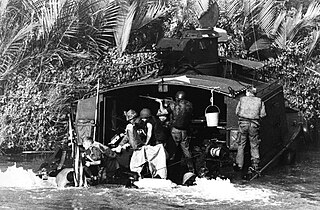
Operation Coronado XI was the eleventh of the Operation Coronado series of riverine military operations conducted by the U.S. Mobile Riverine Force (MRF) and units of the Army of the Republic of Vietnam (ARVN), designed to secure Cần Thơ in the aftermath of the Tet Offensive. It ran from 12 February to 3 March 1968.
Đông Hà Combat Base is a former U.S. Marine Corps and U.S. Army base northwest of Quảng Trị in central Vietnam. The base was first used by the 4th Marines in late April 1966. In mid-July Đông Hà was used by the Marines as a helicopter base and logistics area. Numerous US marine and army units rotated through the base, and several artillery units were based there.

The 9th Marine Expeditionary Brigade was a United States Marine Corps unit.

Operation Double Eagle was a US Marine Corps and Army of the Republic of Vietnam (ARVN) operation that took place in southern Quảng Ngãi Province, lasting from 28 January to 17 February 1966, during the Vietnam War. The operation was mounted in conjunction with Operation Masher in northern Bình Định Province. The operation was inconclusive as the People's Army of Vietnam (PAVN) and the Vietcong (VC) had largely slipped away.

Operation Byrd was a security operation conducted during the Vietnam War by the U.S. 2nd Battalion, 7th Cavalry Regiment and the Army of the Republic of Vietnam (ARVN) 44th Regiment in Bình Thuận Province, South Vietnam from August 1966 to 1 December 1967.

Operation Harvest Moon/Lien Ket 18 was a US Marine Corps and Army of the Republic of Vietnam search and destroy operation in the Quế Sơn Valley in western Quảng Tín Province, lasting from 8 to 20 December 1965.
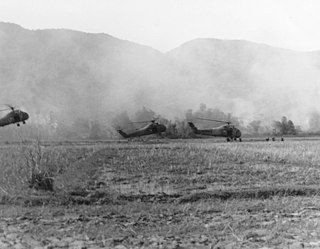
Operation Essex was an operation by the 2nd Battalion, 5th Marines in "Antenna Valley", Hiệp Đức District south of An Hoa Combat Base from 6 to 17 November 1967.
The 2nd Infantry Division also known as Quảng Đà Division or Steel Division is a division of the People's Army of Vietnam (PAVN), first formed from Viet Cong (VC) and PAVN units in October 1965. The first commander and the first commissar of the division were Colonel Nguyễn Năng and Senior Colonel Nguyễn Minh Đức respectively.

Operation Baker was a security operation during the Vietnam War conducted by the U.S. 3rd Brigade, 25th Infantry Division from 22 April to 31 July 1967 in the Đức Phổ District of Quang Ngai Province, South Vietnam.

















